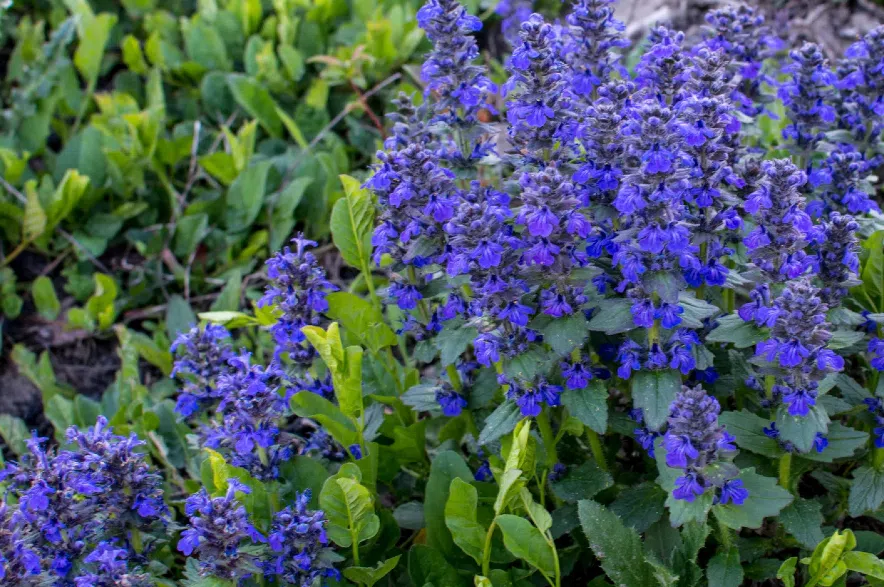Jill and Rick Van Duyvendyk answer all your gardening questions in Garden Talk on 650 CKOM and 980 CJME every Sunday morning at 9 a.m.
Here are some questions and answers from the April 6 show:
Read more:
- Garden Talk: Can I grow apricots in Saskatchewan?
- Garden Talk: Tips for planning a thriving home vegetable garden
- Garden Talk: What should I do now to get my Sask. garden ready for spring?
These questions and answers have been edited and condensed for clarity.
Q: What flowers can I grow in a garden that gets only morning sun?
A: Shady, dry, windy spots are probably one of the hardest locations. You can try a raised bed or xeriscaping, where you put some rocks down with plants like low-growing junipers, sedum, hen and chicks and other perennials.
There is a plant called ajuga which is a perennial, low growing ground cover that gets pretty blue flowers. Another one to try is an annual called kenilworth ivy that has small, white, delicate flowers. Make sure you get irrigation to this ares while it is getting developed.
There’s also mosses like Scotch moss and Irish moss. They look a little bit more like the mosses you would see in the forest, a fluffy moss and impatiens or if you want a little more height, try a Hetz Midget or Danica cedar.
Q: When do you fertilize trees that are hard to get water to?
A: If you have trees that you can’t get water to normally like a row of spruce trees or poplars, now is the time to put some granular fertilizer on top of the snow. The melting snow will pull all that fertilizer into the ground. You can skip waiting for rain this way.
Q: What do I do if my soil pH is higher?
A: Use Groundkeeper Lawn Fertilizer — it’s a 16-10-3-17-3 formula with iron and sulfur to lower the pH.
Q: What should I feed my vegetable seedlings?
A: The seed has enough fertilizer in it to sustain the plant until it gets the second or third set of leaves. Then start fertilizing on a regular basis, about once every two weeks, with 20-20-20 fertilizer at half-strength indoors and when you plant outside switch to a vegetable fertilizer. Don’t use a fertilizer with a high middle number (phosphorus) indoors as it promotes stretching.
Use H-Start probiotic as well because you’re using a soilless mix and there are no natural enzymes in it so it’s going to be hard for the plant to take up the nutrients. You’ll see the signs pretty quickly — if your plants need fertilizer, they will start to look anemic, a sort of a pale green colour.
Q: Can I grow cucumbers in a raised bed and what size container should you have for a tomato plant?
A: Cucumbers are a great candidate for a raised bed, but I would give them something to grow on. Either put a tomato cage around them or even a trellis, an obelisk, or tie three stakes together in the middle so it can climb up. If you have a raised bed against a fence, you can lean the trellis up against the fence so it’s on an angle and then as the cucumber grows the fruit hangs under the trellis.
Tomatoes should be planted in at least a 12 to 14-inch container that is at least 10 to 12 inches deep. If it is too small it is impossible to keep it consistently moist when it gets really hot. Put a tomato cage in the pot as well.
You can use 16 or 18-inch container and plant some herbs, pansies or marigolds around the sides. Those smaller plants can shade the root system and act as a natural mulch. The bigger the better.
Q: How can I prevent snow mold on my lawn right now?
A: Once any ice starts melting, it’s going to be very moist underneath whch provides great conditions for snow mold. As soon as the grass gets exposed, take a leaf rake and keep fluffing up your grass.
You’re not raking it so hard, you’re digging up the soil, it’s just a light fluffing to get the air into the grass. If snow mold does some damage, do some top dressing and reseeding in those areas.
You can use a snowblower on the lawn and spread the snow evenly onto any areas of the grass that are exposed already and that will melt really quickly.
Q: What are the best pear trees to plant both for survival and fresh eating?
A: There are three varieties — Golden Spice, Early Gold or Prairie Welcome and if you plant two different varieties, you’ll have way better crop.
Q: Is there anything I can do to revive the colour of my amaryllis?
A: You need to get some more energy into that bulb. Next time you plant it up, add some bone meal or alfalfa tea and as it’s growing continue to add nutrients so that when it goes dormant the next year, all those nutrients go back into the bulb.
Also watch the pH of the soil If you can get the pH to seven, the plant can take up those nutrients properly and that affects the way that it looks. Just like a blue hydrangea needs a little sulfate in order to be blue.
Q: What is the best way to care for a new orchid?
A: It needs indirect light. When an orchid’s blooming, if you put it in hot sun, you’re going to find the blooms are going to not last as long. Indirect light is two feet away from a bright window.
They are air plants that grow on the sides of tree in nature. The best way to water it i to soak them in water with orchid food in every two weeks.
Once they finish blooming, you can cut the stalk down once it starts to brown and then just wait for it to bloom again. They’ll bloom usually once a year.
Q: If I trim a lilac windbreak to a couple feet from the ground can expect for regrowth by the end of the summer?
A: You can do that right now. You don’t want the buds to swell and leaves forming. After trimming them start fertilizing with 30-10-10 every three weeks from around Mother’s Day and then stop around July 15 and by the end of summer they will be around five feet tall but not really thick.
Q: My backyard faces north. What can I plant on the west side of my deck for privacy that will grow to at least 10 feet tall at maturity?
A: A flowering crab apples called Green Wall would be good. Coloured crab apples like Purple Spire and and Midnight Spire will be more of a greeny purple rather than a nice purple in that position. Parkland Pillar birch would also work and will grow about six feet wide and really tall.
Q: Is it better to water seedling from the bottom tray or the top of the plants?
A: Bottom watering is more consistent and it also gets the roots at the bottom of the container.
Q: How can I get an old peony planted in 1948 in an east facing flower bed to bloom again?
A: Move it to a sunny location. Because it’s so old, it’s probably a big plant, you can look at dividing it as well.
If you divide it, leave some of the plant there and have a nice green plant and then move some of it maybe to another location and it might bloom for you too. Do that as soon as the frost is out of the ground.
Read more:











